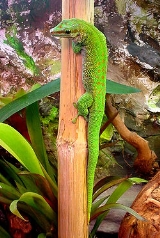
Madagascar day gecko
Encyclopedia
Madagascar day gecko is a diurnal
subspecies
of gecko
s. It lives on the eastern coast of Madagascar
and typically inhabits rainforests and dwells on trees. The Madagascar day gecko feeds on insects and nectar.
 This lizard
This lizard
is one of the largest living day geckos. It can reach a total length of about 22 cm (8.7 in). The body color is light green or bluish green. The skin between the scales often has a light color. A rust-coloured stripe extends from the nostril to behind the eye. On the back there are brownish or red-brick coloured dots which may form a thin line along the mid back. These geckos do not have eyelids, and they have flattened toe pads.
The temperature should be between 25 and 28°C. On warm spot temperature should be 35-40°C. The humidity at night should be maintained between 75 and 90%, on daytime between 60 and 80% In captivity, these animals can be fed with crickets, wax moth larvae, fruit flies, mealworms and houseflies. Fresh tropical fruits, honey and fruity babyfoods are good to maintain their inner moisture.
Diurnal animal
Diurnality is a plant or animal behavior characterized by activity during the day and sleeping at night.-In animals:Animals that are not diurnal might be nocturnal or crepuscular . Many animal species are diurnal, including many mammals, insects, reptiles and birds...
subspecies
Subspecies
Subspecies in biological classification, is either a taxonomic rank subordinate to species, ora taxonomic unit in that rank . A subspecies cannot be recognized in isolation: a species will either be recognized as having no subspecies at all or two or more, never just one...
of gecko
Gecko
Geckos are lizards belonging to the infraorder Gekkota, found in warm climates throughout the world. They range from 1.6 cm to 60 cm....
s. It lives on the eastern coast of Madagascar
Madagascar
The Republic of Madagascar is an island country located in the Indian Ocean off the southeastern coast of Africa...
and typically inhabits rainforests and dwells on trees. The Madagascar day gecko feeds on insects and nectar.
Scientific synonyms
- Gekko madagascariensis Gray 1831
- Phelsuma sarrube [Wiegmann 1834]
- Phelsuma madagascariensis martensi Mertens 1962
- Phelsuma madagascariensis - Glaw & Vences 1994: 290
Appearance

Lizard
Lizards are a widespread group of squamate reptiles, with nearly 3800 species, ranging across all continents except Antarctica as well as most oceanic island chains...
is one of the largest living day geckos. It can reach a total length of about 22 cm (8.7 in). The body color is light green or bluish green. The skin between the scales often has a light color. A rust-coloured stripe extends from the nostril to behind the eye. On the back there are brownish or red-brick coloured dots which may form a thin line along the mid back. These geckos do not have eyelids, and they have flattened toe pads.
Distribution
This species inhabits the whole east coast of Madagascar. It can also be found on the islets Nosy Bohara, Ste. Marie and throughout the Hawaiian Islands. Also, the gecko was deliberately introduced to a restaurant in the Florida Keys, US, by reptile experts. This was due to the garden surrounding the restaurant and the great possibilities it provided for reproduction. The experts come back every year and remove all excess geckos to sell in pet shops.Habitat
P. m. magascariensis is often found on trees along the edges of forests. They also inhabit local huts and banana trees. The east coast of Madagascar because it has a humid and warm climate.Diet
These day geckos feed on many arthropods (insects and arachnids) as well as some fruit matter(mashed). They also like to lick hard, tart fruit, pollen and nectar found on Coonatorious Palm trees.Behavior
Like most Phelsuma spec., the males can be quite quarrelsome and do not accept other males in their neighbourhood. In captivity, where the females cannot escape, the males can also sometimes seriously wound a female. In this case the male and female must be separated.Reproduction
The mating season is between November and the first weeks of April. During this period, the females lay up to 6 pairs of eggs. At a temperature of 28°C, the young will hatch after approximately 55 days. The juveniles measure 55–60 mm.Care and maintenance in captivity
These animals should be housed alone, because they are highly territorial. Male and female pairs can get along but it is common that males harass females too much. They need a large, well planted terrarium.The temperature should be between 25 and 28°C. On warm spot temperature should be 35-40°C. The humidity at night should be maintained between 75 and 90%, on daytime between 60 and 80% In captivity, these animals can be fed with crickets, wax moth larvae, fruit flies, mealworms and houseflies. Fresh tropical fruits, honey and fruity babyfoods are good to maintain their inner moisture.

